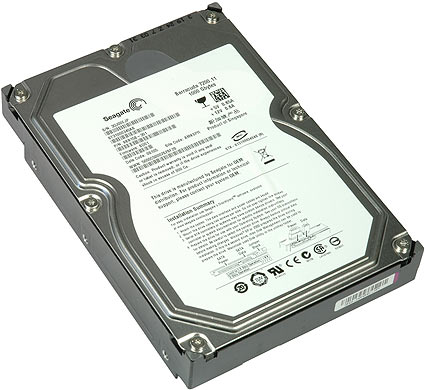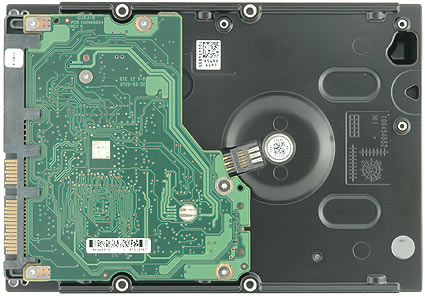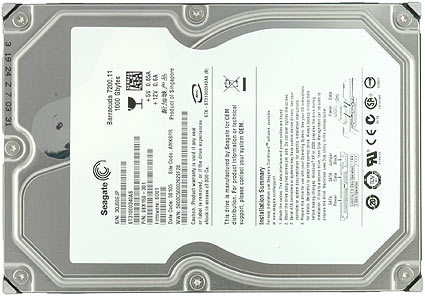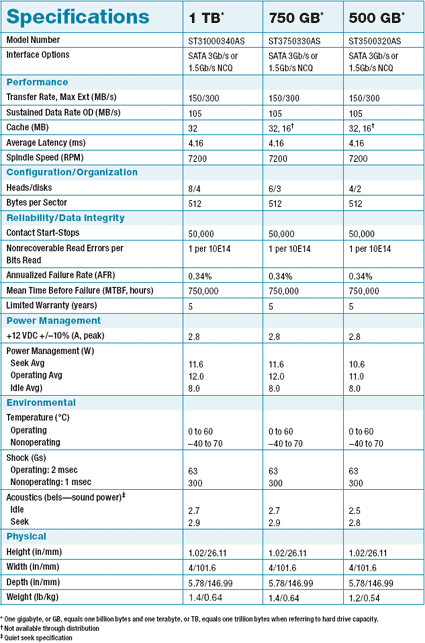The Terabyte Battle
Seagate Barracuda 7200.11 - ST31000340AS (1 TB)
The new "Cuda" is available at three capacity points, to fit the requirements of storage-intensive applications in the workstation segment, the high-end desktop and gaming space, as well as for all applications with a high demand for storage capacity. The smallest 7200.11 drive stores 500 GB, the mid-size model holds 750 GB, and the top model accommodates a full terabyte when calculated at 1000 bytes per kilobyte. Per the binary definition, where one kilobyte equals 1,024 bytes, this drive - as well as the other terabyte HDDs - stores only 931 GB. This is the capacity that Windows will display once you format your terabyte drive, so don't be surprised about the difference. Both are accurate numbers; it's just a question of definition.
Compared to the Barracuda 7200.10, with its <200 GB per platter, the eleventh Barracuda generation increases this figure to approximately 250 GB per platter. Therefore, it is obvious that the new Barracuda 7200.11 employs four platters to get its terabyte of storage together. Western Digital goes the same way with its Caviar GP drive, storing one terabyte on four platters. Hitachi is the only hard drive maker to implement a five platter design with its Deskstar 7K1000.
More platters give hard drive makers the option to release higher capacity drives using proven technology, but every additional platter increases drive weight, power consumption, heat dissipation and in theory even the probability of hardware failures due to wear and tear. In practice, however, it is extremely difficult to prove this, as the hard drive makers do not release the necessary details. As recent history tells us, Hitachi's approach of offering a five-platter terabyte drive rather early gave the firm a 6-month head start and the entry in future history books as the hard drive maker that released the first terabyte drive.
The lower platter count also brings business advantages: the drive maker with the highest per-platter capacity will be able to produce budget drives at the lowest cost. 250 GB capacity per platter makes it possible to produce entry-level hard drives at up to 250 GB total capacity, or 500 GB drives with only two platters. Being able to offer high capacities with the smallest number of parts is the key to being competitive from a business standpoint. It's a pity that we haven't seen Samsung's terabyte hard drive yet, which is expected to store the full terabyte on only three platters.
How does the four platter design look in everyday life? Seagate's datasheet claims a sustained data transfer rate of 105 MB/s, which we could almost reach on a system based on Intel's ICH8 Southbridge. On our storage reference system, the hard drive still jumps over the 100 MB/s mark, and hence is the first desktop hard drive to deliver a three-digit transfer rate. At the same time, it also overtakes the 10,000 RPM Western Digital Raptor drives in most of the benchmarks. Its access time of 12.7 ms is still clearly longer than that of the Raptor, but the new Barracuda 7200.11 beats any other 7200 RPM hard drive with the exception of the aged 7K250 Deskstar by Hitachi. Finally there is a NCQ drive with a decent access time, which the I/O benchmark results reflect well.
We measured a maximum surface temperature of 49°C (120°F) after almost two hours of intensive operation. This is a good result for a four platter drive. However, WD's 750 GB drive has an equal geometry and runs slightly cooler. Vibration and noise are within the known boundaries: a Deskstar 7K1000 by Hitachi makes more noise than the 7200.11, while the WD10EACS by Western Digital is the only terabyte drive that actually is quiet.
Get Tom's Hardware's best news and in-depth reviews, straight to your inbox.
Current page: Seagate Barracuda 7200.11 - ST31000340AS (1 TB)
Prev Page Where Does The Hard Drive Go From Here? Next Page Terabyte HDD Comparison
Patrick Schmid was the editor-in-chief for Tom's Hardware from 2005 to 2006. He wrote numerous articles on a wide range of hardware topics, including storage, CPUs, and system builds.
-
andy_newton The Barracuda gets bricked after 6 months of use. While Seagate is kind enough to offer a free recovery, I lost 3 weeks of my time waiting. Upon receiving its unbricked with new firmware, the performance has now become terribly slow. It is very much different from the last moments before it got bricked.Reply
I contacted the customer service again and they give me a B.S. regarding this particular hard drive is not suitable foe use as external Drive.
I am both terribly surprised and disappointed that tomshardware did not amend any article regarding its performance (post recovery), since those performance charts with its defective firmware should be invalid.
Instead, Tomshardware continues to praise this hard drive and claims that in toms lab the bricking can not be repeated.
I am wondering how much money that seagate pays toms to shut up and not to publish any honest review regarding this other affected hard drives.
Or is it just me (again) waking up in a parallel universe where Seagate has never built any drives with defective firmware.
-ND -
flagoman mmm, you are out of place on your comments, here, couse i dont think that toms would be able to test any hardware for 6 months or until it fails. imagine how late every review would be delayed, its ridiculous,what you are asking what are you six years old??? shezzz... And the company offer you a recovery of the info of your hdd,and actually i found that a great plus, Seagate. but you should had take your info out, and buy a new one.Reply



